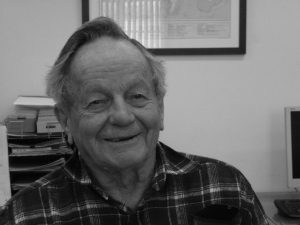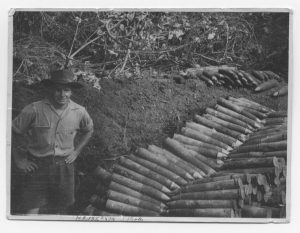- Author
- A.N. Other
- Subjects
- Biographies and personal histories, RAN operations, Post WWII
- Tags
-
- RAN Ships
- None noted.
- Publication
- March 2013 edition of the Naval Historical Review (all rights reserved)
By Leyland Wilkinson
Victor Turner, who on account of his winning ways and fiery temperament, was always known as Paddy, was born to a WW I soldier settler family who farmed about 50 miles from Gladstone, Queensland. On reaching his 18th birthday in 1947 he applied to join the RAN and was shortly at HMAS Cerberus undertaking basic training. Here he qualified in ASW as a Torpedoman Detector (TD3). Following a posting to HMAS Rushcutter he also qualified in Rendering Mines Safe (RMS).

In 1948 as part of the British Commonwealth Occupation Force (BCOF) Vic went to Japan in HMAS Bataan and then returned to Rushcutter as an instructor in underwater detection. Early in 1951 volunteers were sought for a joint Army/Navy Bomb Disposal Team to undertake clearance of the vast amount of unexploded ordnance that remained in the Solomon Islands after the departure of Allied forces. The new team was led by veteran LCDR Charles Croft, MBE, RANR who was supported by Vic and two other ABs with an Army contingent comprising a Warrant Officer, a Sergeant and three Corporals. This team departed from Garden Island in August 1951 on board HMAS Labuan, which had just returned from Heard Island. She had previously known considerable service as LST 3501 but became a commissioned ship in November 1948. They were soon joined by a local force of about 20 men.
When the Japanese occupied the Solomon Islands in April 1942 they commenced building an airfield at Lunga Point, not far from the capital Honiara. With a large labour force, construction proceeded at a rapid pace and the airstrip was completed ahead of schedule on 6 August 1942. On the very next day Allied forces, predominately American Marines, began landing on the island to deny the enemy use of this strategically important airfield which potentially dominated the South West Pacific. After a series of battles in which the Allies lost over 7,000 men the airfield was in Allied hands, to be renamed Henderson Field. Major Lofton Henderson was the first Marine aviator killed when leading his squadron into the Battle of Midway.
No one knows how much unexploded ordnance was left behind following the end of hostilities but at Guadalcanal there were thousands of items ranging from 500 lb bombs to 6 inch shells, land mines, mortars, grenades and every caliber of small arms ammunition. While the main munitions depot was at Hell’s Point there were many other smaller dumps. Hell’s Point was an enormous depot which had been used to stockpile munitions for further operations in the Pacific. Another unfortunate factor was that Hell’s Point had been engulfed by bush fires, resulting in some explosions which scattered other munitions over a wide area. A compounding factor was the arrival of scrap metal merchants seeking materials to be used in post-war reconstruction, especially highly prized brass shell casings. The local population was encouraged to source these, resulting in some horrific injuries and deaths.
While the new Bomb Disposal Team would have preferred to detonate many explosives in situ, especially those partially buried, they were informed that as far as practical all explosives were to be recovered and taken for disposal offshore in deep water. However, the replacement team which arrived one year later were permitted to detonate explosives on land.
The team, now nearly 30 strong, gathered numerous explosives. These were to be found everywhere in front yards, parks and around the outskirts of the airfield. All explosives were taken by truck to the original explosives dump at Hell’s Point.

Here they were loaded on to the small government launch Ramarte then taken out to sea about two tons at a time and lowered over the side into deep water. A photo of Vic from this time which had been sent to his mother has a penciled note on the back which reads ‘Your poor son. These shells aren’t really as heavy as they look, only 100 lbs’.
During this phase of the operation there was a cordite explosion which resulted in three casualties including Vic and Paddy, who was concussed. Two native members of the team were injured and one died. Vic tried to save his injured colleague and for his courage was later awarded the British Empire Medal (BEM). After a year of this dangerous work the team was relieved and came home in the comfort of a DC3.
Vic was not home long before he was off in HMAS Condamine for a year’s service in Korea. He later joined HMAS Woomera and served in her for a further two years, involved in the disposal of unexploded ordnance. Vic paid off from Woomera in August 1959 as a POUW1 and entered civilian life, where he became a plumbing contractor. Tragically Woomera was lost the following year whilst disposing of aged ordnance.
Editor. To this day unexploded ordnance from WWII is still being found in the Solomons, which unfortunately continues to result in a number of tragic injuries and deaths




